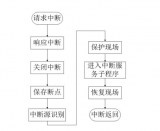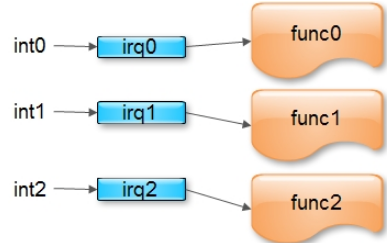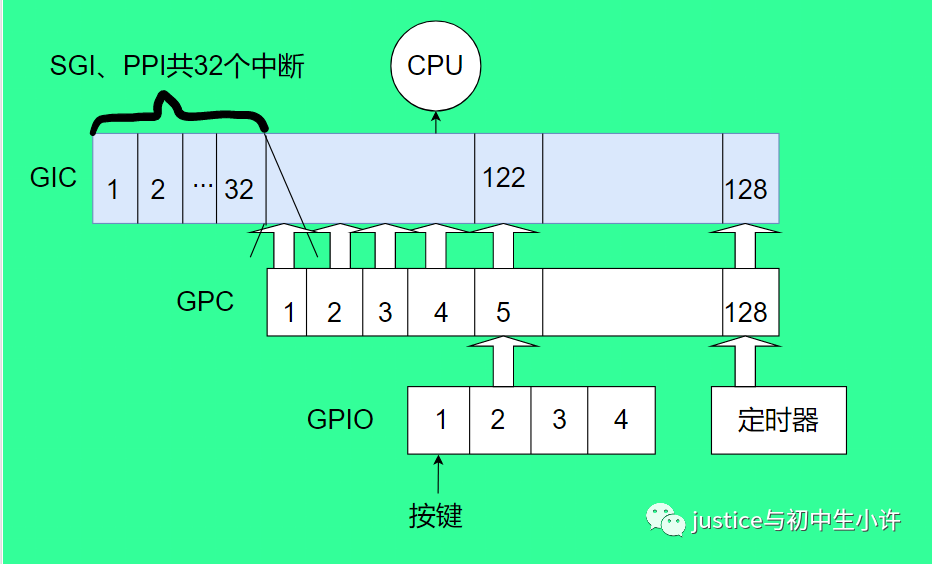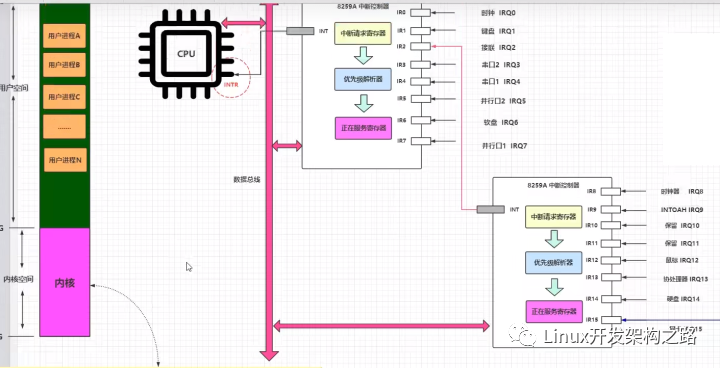1. 中断的概念
中断是指在CPU正常运行期间,由于内外部事件或由程序预先安排的事件引起的 CPU 暂时停止正在运行的程序,转而为该内部或外部事件或预先安排的事件服务的程序中去,服务完毕后再返回去继续运行被暂时中断的程序。Linux中通常分为外部中断(又叫硬件中断)和内部中断(又叫异常)。
软件对硬件进行配置后,软件期望等待硬件的某种状态(比如,收到了数据),这里有两种方式,一种是轮询(polling):CPU 不断的去读硬件状态。另一种是当硬件完成某种事件后,给 CPU 一个中断,让 CPU 停下手上的事情,去处理这个中断。很显然,中断的交互方式提高了系统的吞吐。
当 CPU 收到一个中断 (IRQ)的时候,会去执行该中断对应的处理函数(ISR)。普通情况下,会有一个中断向量表,向量表中定义了 CPU 对应的每一个外设资源的中断处理程序的入口,当发生对应的中断的时候, CPU 直接跳转到这个入口执行程序。也就是中断上下文。(注意:中断上下文中,不可阻塞睡眠)。
2. Linux 中断 top/bottom
玩过 MCU 的人都知道,中断服务程序的设计最好是快速完成任务并退出,因为此刻系统处于被中断中。但是在 ISR 中又有一些必须完成的事情,比如:清中断标志,读/写数据,寄存器操作等。
在 Linux 中,同样也是这个要求,希望尽快的完成 ISR。但事与愿违,有些 ISR 中任务繁重,会消耗很多时间,导致响应速度变差。Linux 中针对这种情况,将中断分为了两部分:
- 上半部(top half):收到一个中断,立即执行,有严格的时间限制,只做一些必要的工作,比如:应答,复位等。这些工作都是在所有中断被禁止的情况下完成的。
- 底半部(bottom half):能够被推迟到后面完成的任务会在底半部进行。在适合的时机,下半部会被开中断执行。
3. 中断处理程序
驱动程序可以使用接口:
request_irq(unsigned int irq, irq_handler_t handler, unsigned long flags,
const char *name, void *dev)
像系统申请注册一个中断处理程序。
其中的参数:

中断标志 flag 的含义:

调用 request _irq 成功执行返回 0。常见错误是 -EBUSY,表示给定的中断线已经在使用(或者没有指定 IRQF_SHARED)
注意:request_irq 函数可能引起睡眠,所以不允许在中断上下文或者不允许睡眠的代码中调用。
释放中断:
const void *free_irq(unsigned int irq, void *dev_id)
用于释放中断处理函数。
注意:Linux 中的中断处理程序是无须重入的。当给定的中断处理程序正在执行的时候,其中断线在所有的处理器上都会被屏蔽掉,以防在同一个中断线上又接收到另一个新的中断。通常情况下,除了该中断的其他中断都是打开的,也就是说其他的中断线上的重点都能够被处理,但是当前的中断线总是被禁止的,故,同一个中断处理程序是绝对不会被自己嵌套的。
4. 中断上下文
与进程上下文不一样,内核执行中断服务程序的时候,处于中断上下文。中断处理程序并没有自己的独立的栈,而是使用了内核栈,其大小一般是有限制的(32bit 机器 8KB)。所以其必须短小精悍。同时中断服务程序是打断了正常的程序流程,这一点上也必须保证快速的执行。同时中断上下文中是不允许睡眠,阻塞的。
中断上下文不能睡眠的原因是:
1、 中断处理的时候,不应该发生进程切换,因为在中断context中,唯一能打断当前中断handler的只有更高优先级的中断,它不会被进程打断,如果在 中断context中休眠,则没有办法唤醒它,因为所有的wake_up_xxx都是针对某个进程而言的,而在中断context中,没有进程的概念,没 有一个task_struct(这点对于softirq和tasklet一样),因此真的休眠了,比如调用了会导致block的例程,内核几乎肯定会死。
2、schedule()在切换进程时,保存当前的进程上下文(CPU寄存器的值、进程的状态以及堆栈中的内容),以便以后恢复此进程运行。中断发生后,内核会先保存当前被中断的进程上下文(在调用中断处理程序后恢复);
但在中断处理程序里,CPU寄存器的值肯定已经变化了吧(最重要的程序计数器PC、堆栈SP等),如果此时因为睡眠或阻塞操作调用了schedule(),则保存的进程上下文就不是当前的进程context了.所以不可以在中断处理程序中调用schedule()。
3、内核中schedule()函数本身在进来的时候判断是否处于中断上下文:
if(unlikely(in_interrupt()))
BUG();
因此,强行调用schedule()的结果就是内核BUG。
4、中断handler会使用被中断的进程内核堆栈,但不会对它有任何影响,因为handler使用完后会完全清除它使用的那部分堆栈,恢复被中断前的原貌。
5、处于中断context时候,内核是不可抢占的。因此,如果休眠,则内核一定挂起。
5. 举例
比如 RTC 驱动程序 (drivers/char/rtc.c)。在 RTC 驱动的初始化阶段,会调用到 rtc_init 函数:
module_init(rtc_init);
在这个初始化函数中调用到了 request_irq 用于申请中断资源,并注册服务程序:
static int __init rtc_init(void)
{
...
rtc_int_handler_ptr = rtc_interrupt;
...
request_irq(RTC_IRQ, rtc_int_handler_ptr, 0, "rtc", NULL)
...
}
RTC_IRQ 是中断号,和处理器绑定。
rtc_interrupt 是中断处理程序:
static irqreturn_t rtc_interrupt(int irq, void dev_id)
{
/
- Can be an alarm interrupt, update complete interrupt,
- or a periodic interrupt. We store the status in the
- low byte and the number of interrupts received since
- the last read in the remainder of rtc_irq_data.
*/
spin_lock(&rtc_lock);
rtc_irq_data += 0x100;
rtc_irq_data &= ~0xff;
if (is_hpet_enabled()) {
/*
* In this case it is HPET RTC interrupt handler
* calling us, with the interrupt information
* passed as arg1, instead of irq.
*/
rtc_irq_data |= (unsigned long)irq & 0xF0;
} else {
rtc_irq_data |= (CMOS_READ(RTC_INTR_FLAGS) & 0xF0);
}
if (rtc_status & RTC_TIMER_ON)
mod_timer(&rtc_irq_timer, jiffies + HZ/rtc_freq + 2*HZ/100);
spin_unlock(&rtc_lock);
wake_up_interruptible(&rtc_wait);
kill_fasync(&rtc_async_queue, SIGIO, POLL_IN);
return IRQ_HANDLED;
}
每次收到 RTC 中断,就会调用进这个函数。
6. 中断处理流程
发生中断时,CPU执行异常向量vector_irq的代码, 即异常向量表中的中断异常的代码,它是一个跳转指令,跳去执行真正的中断处理程序,在vector_irq里面,最终会调用中断处理的总入口函数。
C 语言的入口为 :asm_do_IRQ(unsigned int irq, struct pt_regs *regs)
asmlinkage void __exception_irq_entry
asm_do_IRQ(unsigned int irq, struct pt_regs *regs)
{
handle_IRQ(irq, regs);
}
该函数的入参 irq 为中断号。
asm_do_IRQ -> handle_IRQ
void handle_IRQ(unsigned int irq, struct pt_regs *regs)
{
__handle_domain_irq(NULL, irq, false, regs);
}
handle_IRQ -> __handle_domain_irq
int __handle_domain_irq(struct irq_domain *domain, unsigned int hwirq,
bool lookup, struct pt_regs *regs)
{
struct pt_regs *old_regs = set_irq_regs(regs);
unsigned int irq = hwirq;
int ret = 0;
irq_enter();
#ifdef CONFIG_IRQ_DOMAIN
if (lookup)
irq = irq_find_mapping(domain, hwirq);
#endif
/*
* Some hardware gives randomly wrong interrupts. Rather
* than crashing, do something sensible.
*/
if (unlikely(!irq || irq >= nr_irqs)) {
ack_bad_irq(irq);
ret = -EINVAL;
} else {
generic_handle_irq(irq);
}
irq_exit();
set_irq_regs(old_regs);
return ret;
}
这里请注意:
先调用了 irq_enter 标记进入了硬件中断:
irq_enter是更新一些系统的统计信息,同时在__irq_enter宏中禁止了进程的抢占。虽然在产生IRQ时,ARM会自动把CPSR中的I位置位,禁止新的IRQ请求,直到中断控制转到相应的流控层后才通过local_irq_enable()打开。那为何还要禁止抢占?这是因为要考虑中断嵌套的问题,一旦流控层或驱动程序主动通过local_irq_enable打开了IRQ,而此时该中断还没处理完成,新的irq请求到达,这时代码会再次进入irq_enter,在本次嵌套中断返回时,内核不希望进行抢占调度,而是要等到最外层的中断处理完成后才做出调度动作,所以才有了禁止抢占这一处理
再调用 generic_handle_irq
最后调用 irq_exit 删除进入硬件中断的标记
__handle_domain_irq -> generic_handle_irq
int generic_handle_irq(unsigned int irq)
{
struct irq_desc *desc = irq_to_desc(irq);
if (!desc)
return -EINVAL;
generic_handle_irq_desc(desc);
return 0;
}
EXPORT_SYMBOL_GPL(generic_handle_irq);
首先在函数irq_to_desc中根据发生中断的中断号,去取出它的 irq_desc 中断描述结构,然后调用 generic_handle_irq_desc:
static inline void generic_handle_irq_desc(struct irq_desc *desc)
{
desc->handle_irq(desc);
}
这里调用了 handle_irq 函数。
所以,在上述流程中,还需要分析 irq_to_desc 流程:
struct irq_desc *irq_to_desc(unsigned int irq)
{
return (irq < NR_IRQS) ? irq_desc + irq : NULL;
}
EXPORT_SYMBOL(irq_to_desc);
NR_IRQS 是支持的总的中断个数,当然,irq 不能够大于这个数目。所以返回 irq_desc + irq。
irq_desc 是一个全局的数组:
struct irq_desc irq_desc[NR_IRQS] __cacheline_aligned_in_smp = {
[0 ... NR_IRQS-1] = {
.handle_irq = handle_bad_irq,
.depth = 1,
.lock = __RAW_SPIN_LOCK_UNLOCKED(irq_desc->lock),
}
};
这里是这个数组的初始化的地方。所有的 handle_irq 函数都被初始化成为了 handle_bad_irq。
细心的观众可能发现了,调用这个 desc->handle_irq(desc) 函数,并不是咱们注册进去的中断处理函数啊,因为两个函数的原型定义都不一样。这个 handle_irq 是 irq_flow_handler_t 类型,而我们注册进去的服务程序是 irq_handler_t,这两个明显不是同一个东西,所以这里我们还需要继续分析。
6.1 中断相关的数据结构
Linux 中断相关的数据结构有 3 个

irq_desc 结构如下
struct irq_desc {
struct irq_common_data irq_common_data;
struct irq_data irq_data;
unsigned int __percpu *kstat_irqs;
irq_flow_handler_t handle_irq;
#ifdef CONFIG_IRQ_PREFLOW_FASTEOI
irq_preflow_handler_t preflow_handler;
#endif
struct irqaction action; / IRQ action list /
unsigned int status_use_accessors;
unsigned int core_internal_state__do_not_mess_with_it;
unsigned int depth; / nested irq disables /
unsigned int wake_depth; / nested wake enables /
unsigned int irq_count; / For detecting broken IRQs /
unsigned long last_unhandled; / Aging timer for unhandled count */
unsigned int irqs_unhandled;
atomic_t threads_handled;
int threads_handled_last;
raw_spinlock_t lock;
struct cpumask *percpu_enabled;
const struct cpumask *percpu_affinity;
#ifdef CONFIG_SMP
const struct cpumask *affinity_hint;
struct irq_affinity_notify *affinity_notify;
#ifdef CONFIG_GENERIC_PENDING_IRQ
cpumask_var_t pending_mask;
#endif
#endif
unsigned long threads_oneshot;
atomic_t threads_active;
wait_queue_head_t wait_for_threads;
#ifdef CONFIG_PM_SLEEP
unsigned int nr_actions;
unsigned int no_suspend_depth;
unsigned int cond_suspend_depth;
unsigned int force_resume_depth;
#endif
#ifdef CONFIG_PROC_FS
struct proc_dir_entry *dir;
#endif
#ifdef CONFIG_GENERIC_IRQ_DEBUGFS
struct dentry *debugfs_file;
const char *dev_name;
#endif
#ifdef CONFIG_SPARSE_IRQ
struct rcu_head rcu;
struct kobject kobj;
#endif
struct mutex request_mutex;
int parent_irq;
struct module *owner;
const char *name;
} ____cacheline_internodealigned_in_smp;
irqaction 结构如下:
/**
- struct irqaction - per interrupt action descriptor
- @handler: interrupt handler function
- @name: name of the device
- @dev_id: cookie to identify the device
- @percpu_dev_id: cookie to identify the device
- @next: pointer to the next irqaction for shared interrupts
- @irq: interrupt number
- @flags: flags (see IRQF_* above)
- @thread_fn: interrupt handler function for threaded interrupts
- @thread: thread pointer for threaded interrupts
- @secondary: pointer to secondary irqaction (force threading)
- @thread_flags: flags related to @thread
- @thread_mask: bitmask for keeping track of @thread activity
- @dir: pointer to the proc/irq/NN/name entry
*/
struct irqaction {
irq_handler_t handler;
void *dev_id;
void __percpu *percpu_dev_id;
struct irqaction *next;
irq_handler_t thread_fn;
struct task_struct *thread;
struct irqaction *secondary;
unsigned int irq;
unsigned int flags;
unsigned long thread_flags;
unsigned long thread_mask;
const char *name;
struct proc_dir_entry *dir;
} ____cacheline_internodealigned_in_smp;
irq_chip 描述如下:
/**
struct irq_chip - hardware interrupt chip descriptor
@parent_device: pointer to parent device for irqchip
@name: name for /proc/interrupts
@irq_startup: start up the interrupt (defaults to ->enable if NULL)
@irq_shutdown: shut down the interrupt (defaults to ->disable if NULL)
@irq_enable: enable the interrupt (defaults to chip->unmask if NULL)
@irq_disable: disable the interrupt
@irq_ack: start of a new interrupt
@irq_mask: mask an interrupt source
@irq_mask_ack: ack and mask an interrupt source
@irq_unmask: unmask an interrupt source
@irq_eoi: end of interrupt
@irq_set_affinity: Set the CPU affinity on SMP machines. If the force
argument is true, it tells the driver tounconditionally apply the affinity setting. Sanitychecks against the supplied affinity mask are notrequired. This is used for CPU hotplug where thetarget CPU is not yet set in the cpu_online_mask.@irq_retrigger: resend an IRQ to the CPU
@irq_set_type: set the flow type (IRQ_TYPE_LEVEL/etc.) of an IRQ
@irq_set_wake: enable/disable power-management wake-on of an IRQ
@irq_bus_lock: function to lock access to slow bus (i2c) chips
@irq_bus_sync_unlock:function to sync and unlock slow bus (i2c) chips
@irq_cpu_online: configure an interrupt source for a secondary CPU
@irq_cpu_offline: un-configure an interrupt source for a secondary CPU
@irq_suspend: function called from core code on suspend once per
chip, when one or more interrupts are installed@irq_resume: function called from core code on resume once per chip,
when one ore more interrupts are installed@irq_pm_shutdown: function called from core code on shutdown once per chip
@irq_calc_mask: Optional function to set irq_data.mask for special cases
@irq_print_chip: optional to print special chip info in show_interrupts
@irq_request_resources: optional to request resources before calling
any other callback related to this irq@irq_release_resources: optional to release resources acquired with
irq_request_resources@irq_compose_msi_msg: optional to compose message content for MSI
@irq_write_msi_msg: optional to write message content for MSI
@irq_get_irqchip_state: return the internal state of an interrupt
@irq_set_irqchip_state: set the internal state of a interrupt
@irq_set_vcpu_affinity: optional to target a vCPU in a virtual machine
@ipi_send_single: send a single IPI to destination cpus
@ipi_send_mask: send an IPI to destination cpus in cpumask
@flags: chip specific flags
*/
struct irq_chip {
struct device *parent_device;
const char *name;
unsigned int (*irq_startup)(struct irq_data *data);
void (*irq_shutdown)(struct irq_data *data);
void (*irq_enable)(struct irq_data *data);
void (*irq_disable)(struct irq_data *data);void (*irq_ack)(struct irq_data *data);
void (*irq_mask)(struct irq_data *data);
void (*irq_mask_ack)(struct irq_data *data);
void (*irq_unmask)(struct irq_data *data);
void (*irq_eoi)(struct irq_data *data);int (*irq_set_affinity)(struct irq_data *data, const struct cpumask *dest, bool force);
int (*irq_retrigger)(struct irq_data *data);
int (*irq_set_type)(struct irq_data *data, unsigned int flow_type);
int (*irq_set_wake)(struct irq_data *data, unsigned int on);void (*irq_bus_lock)(struct irq_data *data);
void (*irq_bus_sync_unlock)(struct irq_data *data);void (*irq_cpu_online)(struct irq_data *data);
void (*irq_cpu_offline)(struct irq_data *data);void (*irq_suspend)(struct irq_data *data);
void (*irq_resume)(struct irq_data *data);
void (*irq_pm_shutdown)(struct irq_data *data);void (*irq_calc_mask)(struct irq_data *data);
void (*irq_print_chip)(struct irq_data *data, struct seq_file *p);
int (*irq_request_resources)(struct irq_data *data);
void (*irq_release_resources)(struct irq_data *data);void (*irq_compose_msi_msg)(struct irq_data *data, struct msi_msg *msg);
void (*irq_write_msi_msg)(struct irq_data *data, struct msi_msg *msg);int (*irq_get_irqchip_state)(struct irq_data *data, enum irqchip_irq_state which, bool *state);
int (*irq_set_irqchip_state)(struct irq_data *data, enum irqchip_irq_state which, bool state);int (*irq_set_vcpu_affinity)(struct irq_data *data, void *vcpu_info);
void (*ipi_send_single)(struct irq_data *data, unsigned int cpu);
void (*ipi_send_mask)(struct irq_data *data, const struct cpumask *dest);unsigned long flags;
};
irq_chip 是一串和芯片相关的函数指针,这里定义的非常的全面,基本上和 IRQ 相关的可能出现的操作都全部定义进去了,具体根据不同的芯片,需要在不同的芯片的地方去初始化这个结构,然后这个结构会嵌入到通用的 IRQ 处理软件中去使用,使得软件处理逻辑和芯片逻辑完全的分开。
好,我们接下来继续前进。
6.2 初始化 Chip 相关的 IRQ
众所周知,启动的时候,C 语言从 start_kernel 开始,在这里面,调用了和 machine 相关的 IRQ 的初始化 init_IRQ():
asmlinkage __visible void __init start_kernel(void)
{
char *command_line;
char *after_dashes;
.....
early_irq_init();
init_IRQ();
.....
}
在 init_IRQ 中,调用了machine_desc->init_irq():
void __init init_IRQ(void)
{
int ret;
if (IS_ENABLED(CONFIG_OF) && !machine_desc->init_irq)
irqchip_init();
else
machine_desc->init_irq();
if (IS_ENABLED(CONFIG_OF) && IS_ENABLED(CONFIG_CACHE_L2X0) &&
(machine_desc->l2c_aux_mask || machine_desc->l2c_aux_val)) {
if (!outer_cache.write_sec)
outer_cache.write_sec = machine_desc->l2c_write_sec;
ret = l2x0_of_init(machine_desc->l2c_aux_val,
machine_desc->l2c_aux_mask);
if (ret && ret != -ENODEV)
pr_err("L2C: failed to init: %dn", ret);
}
uniphier_cache_init();
}

machine_desc->init_irq() 完成对中断控制器的初始化,为每个irq_desc结构安装合适的流控handler,为每个irq_desc结构安装irq_chip指针,使他指向正确的中断控制器所对应的irq_chip结构的实例,同时,如果该平台中的中断线有多路复用(多个中断公用一个irq中断线)的情况,还应该初始化irq_desc中相应的字段和标志,以便实现中断控制器的级联。
这里初始化的时候回调用到具体的芯片相关的中断初始化的地方。
例如:
int __init s5p_init_irq_eint(void)
{
int irq;
for (irq = IRQ_EINT(0); irq <= IRQ_EINT(15); irq++)
irq_set_chip(irq, &s5p_irq_vic_eint);
for (irq = IRQ_EINT(16); irq <= IRQ_EINT(31); irq++) {
irq_set_chip_and_handler(irq, &s5p_irq_eint, handle_level_irq);
set_irq_flags(irq, IRQF_VALID);
}
irq_set_chained_handler(IRQ_EINT16_31, s5p_irq_demux_eint16_31);
return 0;
}
而在这些里面,都回去调用类似于:
void
irq_set_chip_and_handler_name(unsigned int irq, struct irq_chip *chip,
irq_flow_handler_t handle, const char *name);
irq_set_handler(unsigned int irq, irq_flow_handler_t handle)
{
__irq_set_handler(irq, handle, 0, NULL);
}
static inline void
irq_set_chained_handler(unsigned int irq, irq_flow_handler_t handle)
{
__irq_set_handler(irq, handle, 1, NULL);
}
void
irq_set_chained_handler_and_data(unsigned int irq, irq_flow_handler_t handle,
void *data);
这些函数定义在 include/linux/irq.h 文件。是对芯片初始化的时候可见的 APIs,用于指定中断“流控”中的 :
irq_flow_handler_t handle
也就是中断来的时候,最后那个函数调用。
中断流控函数,分几种,电平触发的中断,边沿触发的,等:
/*
- Built-in IRQ handlers for various IRQ types,
- callable via desc->handle_irq()
*/
extern void handle_level_irq(struct irq_desc *desc);
extern void handle_fasteoi_irq(struct irq_desc *desc);
extern void handle_edge_irq(struct irq_desc *desc);
extern void handle_edge_eoi_irq(struct irq_desc *desc);
extern void handle_simple_irq(struct irq_desc *desc);
extern void handle_untracked_irq(struct irq_desc *desc);
extern void handle_percpu_irq(struct irq_desc *desc);
extern void handle_percpu_devid_irq(struct irq_desc *desc);
extern void handle_bad_irq(struct irq_desc *desc);
extern void handle_nested_irq(unsigned int irq);
而在这些处理函数里,会去调用到 :handle_irq_event
比如:
/**
handle_level_irq - Level type irq handler
@desc: the interrupt description structure for this irq
Level type interrupts are active as long as the hardware line has
the active level. This may require to mask the interrupt and unmask
it after the associated handler has acknowledged the device, so the
interrupt line is back to inactive.
*/
void handle_level_irq(struct irq_desc *desc)
{
raw_spin_lock(&desc->lock);
mask_ack_irq(desc);if (!irq_may_run(desc))
goto out_unlock;desc->istate &= ~(IRQS_REPLAY | IRQS_WAITING);
/*
- If its disabled or no action available
- keep it masked and get out of here
*/
if (unlikely(!desc->action || irqd_irq_disabled(&desc->irq_data))) {
desc->istate |= IRQS_PENDING;
goto out_unlock;
}
kstat_incr_irqs_this_cpu(desc);
handle_irq_event(desc);cond_unmask_irq(desc);
out_unlock:
raw_spin_unlock(&desc->lock);
}
而这个 handle_irq_event 则是调用了处理,handle_irq_event_percpu:
irqreturn_t handle_irq_event(struct irq_desc *desc)
{
irqreturn_t ret;
desc->istate &= ~IRQS_PENDING;
irqd_set(&desc->irq_data, IRQD_IRQ_INPROGRESS);
raw_spin_unlock(&desc->lock);
ret = handle_irq_event_percpu(desc);
raw_spin_lock(&desc->lock);
irqd_clear(&desc->irq_data, IRQD_IRQ_INPROGRESS);
return ret;
}
handle_irq_event_percpu->__handle_irq_event_percpu-> 【action->handler()】
这里终于看到了调用 的地方了,就是咱们通过 request_irq 注册进去的函数
7. /proc/interrupts
这个 proc 下放置了对应中断号的中断次数和对应的 dev-name
-
cpu
+关注
关注
68文章
10869浏览量
211850 -
Linux
+关注
关注
87文章
11310浏览量
209581 -
程序
+关注
关注
117文章
3787浏览量
81069 -
函数
+关注
关注
3文章
4332浏览量
62645
发布评论请先 登录
相关推荐
Linux内核中断设计与实现
linux中断处理机制 中断处理过程

浅析linux gpio中断
面向嵌入式Linux系统的软中断设计与实现
Linux 2.6 中断处理原理简介
linux驱动之中断处理过程C程序部分
linux中断处理之IRQ中断
riscv中的plic中断处理与eclic详解





 Linux中断处理浅析
Linux中断处理浅析














评论